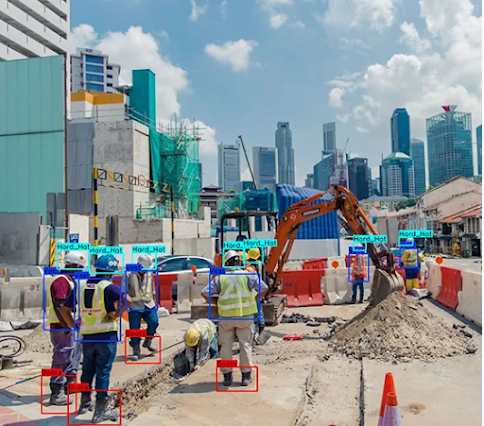Summary Reader Response Draft 2
The article
“Transforming Workplace Safety: Harnessing AI for Real-Time PPE Monitoring”
explores the impact of Personal Protective Equipment (PPE) detection by AI and
several advantages of the use of AI to deal with non-compliance of not wearing
PPE (Rebecca, L., n.d).
The system,
empowered with AI-enabled image and video analysis, can identify various
personal protective equipment, promptly sending alerts for individuals who do
not have proper gear (Lambert, R. 2023). Based on one of the few companies that
supply this system, the system offers remote construction site monitoring and
provides centralized oversight to managers through a user-friendly platform and
by sending real-time safety alerts for PPE non-compliance. It also provides
workplace recordings to obtain video data on workplace safety and potential
hazards for identifying and preventing accidents (V3 Smart Technologies, 2024).
The system simply works by obtaining red-green-blue (RGB) images from CCTV,
which are transmitted through a monitoring system responsible for ‘detection
and verification’ and ID association, and sending off alarms regarding non-compliant workers (SCITEPRESS, 2021).
The
state-of-the-art system enhances safety and productivity within construction
sites.
In my
research for an advanced technology or a system that can be used at
construction sites, real-time PPE detection with AI and computer vision stands
out the most as it brings great benefits for both managers such as
supervisors, and safety officers, as well as construction workers. On top of that, in fact,
construction industry is recognized as one of the top contributors to all fatalities and
injuries in Singapore (Workplace Safety and Health Report, 2023). Hence, this system is highly relevant for use in construction industry. Even
though it may seem beneficial to use this system at construction sites, it is
worth considering a limitation that it may pose for a better understanding of
how reliable this system is for construction use.
The first
advantage of the system is that it eliminates manual detection errors which
results in a boost in productivity of managers (Rebecca, L., n.d). The
AI-driven PPE compliments the work of managers in ensuring workers wear PPE.
Managers will be more productive as the system allows them to focus on more
important tasks without having to monitor the workers repetitively and
laboriously at construction sites and check whether they are wearing PPE.
Hence, the elimination of manual detection of PPE will bring productivity among
managers.
The second
advantage is that managers will receive instant alerts for hazardous activities
(Rebecca, L. n.d). Managers will receive alerts promptly and remotely for any non-compliance
for not wearing PPE among workers at construction sites. Therefore, managers
can make corrections before workers perform construction work and reinstate the
importance of safety among workers. In this way, managers can prevent
unforeseeable injuries or fatalities. Instant alerts do not just help with
prompting managers for immediate correction but also make them think and put in
place proper precautions before workers perform any construction work in the
future.
Although it
may seem that the system is favorable for use in construction, it also poses a
considerable limitation. As the system is run by Artificial Intelligence (AI),
many people perceive AI-based decision-making as more impartial than
human-based methods due to its sophisticated and extensive data (NCS, 2023).
However, examples learned by AI might amplify subjective and harmful biases and
beliefs ingrained in training data (NCS, 2023). The training data imposes
restrictions on workers strictly for full compliance to wear necessary PPE
based on the system’s training data (NCS, 2023). This may cause unproductivity
and inconvenience for workers as they must strictly abide by wearing PPE at
construction sites. Based on a study, some workers do not comply with wearing
PPE due to the ‘discomfort of wearing PPE’ and ‘the feeling that PPE interferes
with their work’ (ScienceDirect, 2020). Therefore, managers should always
remember that the system only compliments their work by ensuring that workers
wear PPE to reduce workplace accidents. Ultimately, they should assess the AI's
data to determine the relevance of full PPE in specific construction works.
This evaluation will help decide whether a worker should wear PPE for certain
construction tasks with the aim to preserve the convenience and productivity of the
workers.
In
conclusion, the idea of the system is useful as it compliments the work of
managers in ensuring that workers wear PPE to further minimize injuries and
fatalities in construction. The advantage of accessibility to video data and
instant alerts is essential for managers to boost their productivity so that
they can focus on other crucial tasks. The use of the system brings benefits
and is reliable for use at construction sites.
Sources:
Lambert, R.
(2023, December 11). Transforming workplace safety: Harnessing AI for
Real-Time PPE Monitoring. HSE
People. https://www.hsepeople.com/transforming-workplace-safety-harnessing-ai-for-real-time-ppe-monitoring/
V3 Smart
Technologies. (2023, July 11). PPE Detection System | Enhance your
construction site safety. V3 Smart
Technologies. https://v3smarttech.com/ai-solutions/ppe-detection/
SCITEPRESS.
(2021). A Robust Real-time Component for Personal Protective Equipment
Detection in an Industrial Setting. SCITEPRESS.
https://www.scitepress.org/Papers/2021/104526/104526.pdf
Using Data
and AI to Gain Insights into Your Safety Program. (2023). https://www.nsc.org/.
Retrieved February 12, 2024, from https://www.nsc.org/getmedia/0e837673-651b-4763-bc99-b3991d32001a/predictive-analytics-machine-learning-priority-tech-wp.pdf
ScienceDirect.
(2020). Deep learning for site safety: Real-time detection of personal
protective equipment. Automation in Construction, 112,
103085. https://doi.org/10.1016/j.autcon.2020.103085

Comments
Post a Comment